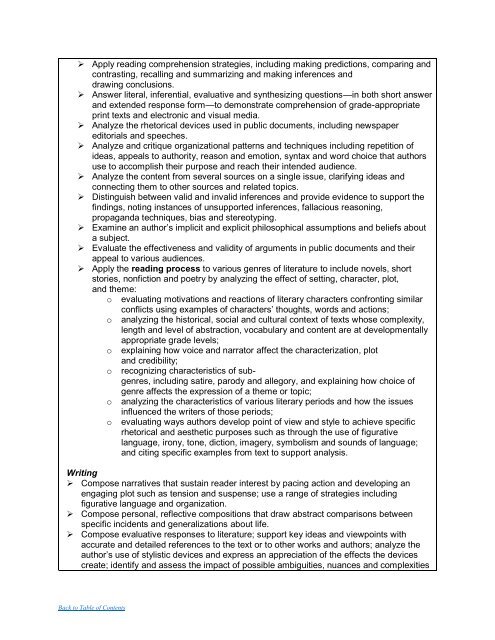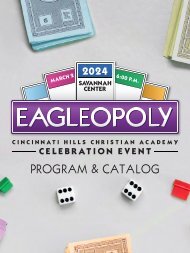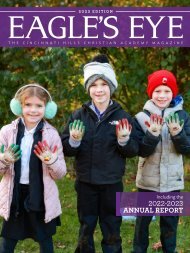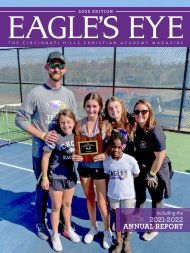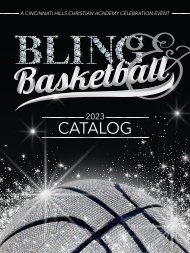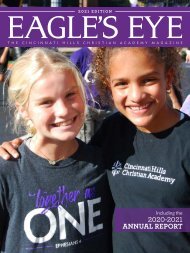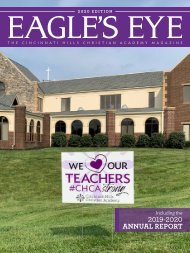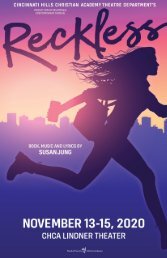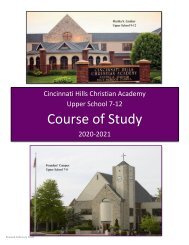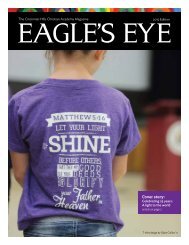Mission, Vision, Competencies, Standards, and Benchmarks
A Statement of Curriculum CINCINNATI HILLS CHRISTIAN ACADEMY Edyth B. Lindner Campus Otto Armleder Memorial Education Center Founders’ Campus Martha S. Lindner Campus 2019 Edition
A Statement of Curriculum
CINCINNATI HILLS CHRISTIAN ACADEMY
Edyth B. Lindner Campus
Otto Armleder Memorial Education Center
Founders’ Campus
Martha S. Lindner Campus
2019 Edition
You also want an ePaper? Increase the reach of your titles
YUMPU automatically turns print PDFs into web optimized ePapers that Google loves.
‣ Apply reading comprehension strategies, including making predictions, comparing <strong>and</strong><br />
contrasting, recalling <strong>and</strong> summarizing <strong>and</strong> making inferences <strong>and</strong><br />
drawing conclusions.<br />
‣ Answer literal, inferential, evaluative <strong>and</strong> synthesizing questions—in both short answer<br />
<strong>and</strong> extended response form—to demonstrate comprehension of grade-appropriate<br />
print texts <strong>and</strong> electronic <strong>and</strong> visual media.<br />
‣ Analyze the rhetorical devices used in public documents, including newspaper<br />
editorials <strong>and</strong> speeches.<br />
‣ Analyze <strong>and</strong> critique organizational patterns <strong>and</strong> techniques including repetition of<br />
ideas, appeals to authority, reason <strong>and</strong> emotion, syntax <strong>and</strong> word choice that authors<br />
use to accomplish their purpose <strong>and</strong> reach their intended audience.<br />
‣ Analyze the content from several sources on a single issue, clarifying ideas <strong>and</strong><br />
connecting them to other sources <strong>and</strong> related topics.<br />
‣ Distinguish between valid <strong>and</strong> invalid inferences <strong>and</strong> provide evidence to support the<br />
findings, noting instances of unsupported inferences, fallacious reasoning,<br />
propag<strong>and</strong>a techniques, bias <strong>and</strong> stereotyping.<br />
‣ Examine an author’s implicit <strong>and</strong> explicit philosophical assumptions <strong>and</strong> beliefs about<br />
a subject.<br />
‣ Evaluate the effectiveness <strong>and</strong> validity of arguments in public documents <strong>and</strong> their<br />
appeal to various audiences.<br />
‣ Apply the reading process to various genres of literature to include novels, short<br />
stories, nonfiction <strong>and</strong> poetry by analyzing the effect of setting, character, plot,<br />
<strong>and</strong> theme:<br />
o evaluating motivations <strong>and</strong> reactions of literary characters confronting similar<br />
conflicts using examples of characters’ thoughts, words <strong>and</strong> actions;<br />
o analyzing the historical, social <strong>and</strong> cultural context of texts whose complexity,<br />
length <strong>and</strong> level of abstraction, vocabulary <strong>and</strong> content are at developmentally<br />
appropriate grade levels;<br />
o explaining how voice <strong>and</strong> narrator affect the characterization, plot<br />
<strong>and</strong> credibility;<br />
o recognizing characteristics of subgenres,<br />
including satire, parody <strong>and</strong> allegory, <strong>and</strong> explaining how choice of<br />
genre affects the expression of a theme or topic;<br />
o analyzing the characteristics of various literary periods <strong>and</strong> how the issues<br />
influenced the writers of those periods;<br />
o evaluating ways authors develop point of view <strong>and</strong> style to achieve specific<br />
rhetorical <strong>and</strong> aesthetic purposes such as through the use of figurative<br />
language, irony, tone, diction, imagery, symbolism <strong>and</strong> sounds of language;<br />
<strong>and</strong> citing specific examples from text to support analysis.<br />
Writing<br />
‣ Compose narratives that sustain reader interest by pacing action <strong>and</strong> developing an<br />
engaging plot such as tension <strong>and</strong> suspense; use a range of strategies including<br />
figurative language <strong>and</strong> organization.<br />
‣ Compose personal, reflective compositions that draw abstract comparisons between<br />
specific incidents <strong>and</strong> generalizations about life.<br />
‣ Compose evaluative responses to literature; support key ideas <strong>and</strong> viewpoints with<br />
accurate <strong>and</strong> detailed references to the text or to other works <strong>and</strong> authors; analyze the<br />
author’s use of stylistic devices <strong>and</strong> express an appreciation of the effects the devices<br />
create; identify <strong>and</strong> assess the impact of possible ambiguities, nuances <strong>and</strong> complexities<br />
Back to Table of Contents


